One of the most distinctive and elegant tour boats that cruised the 1000 Islands in the last half of the twentieth century was Miss Kingston. This former Royal Canadian Navy (RCN) vessel was easily recognizable at a distance, because of both her shape and size. At 112-feet in length, she was the largest tour boat in the area at the time.
Miss Kingston began life as Q096, a Fairmile B Motor Launch, built by Minnett-Shields Limited at their shipyard in Bracebridge, Ontario. Contracts for several dozen of these small warships were issued to boatbuilders all across Canada in 1941, in order to bolster the coastal defence forces, especially on the East coast where German U-boats were posing a substantial risk to both military and merchant shipping in the St. Lawrence River and the Gulf of St. Lawrence.
Canadian builders based the vessel's design on the British Type B Fairmile motor launches, deployed for anti-submarine work in British waters. Despite British performance trial results that were less than optimum for the particular tasks that the boats would be assigned, the RCN decided to go ahead with the program to get boats in the water as quickly as possible. Construction of Q096 began on April 20, 1942, with the laying of the keel, and she launched on October 19, 1942. The RCN took delivery of the newly constructed vessel on November 9, 1942. The design specifications for the group of boats that included Q096 were as shown in the table below.
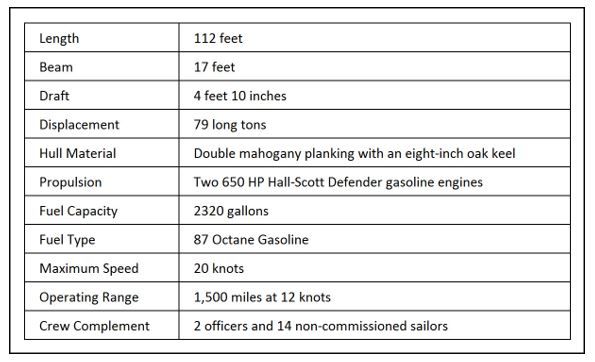
According to historical records, the Q096 Fairmile B was never recognized as a commissioned RCN ship, because she served as a tender to HMCS Sambro, the depot ship for escorts. Apparently, tenders were never commissioned into the Navy, even though they sailed under the White Ensign flag. At the time of her retirement from the Royal Canadian Navy in 1945, Q096 was listed as part of the 76th Motor Launch Flotilla, based out of Halifax.
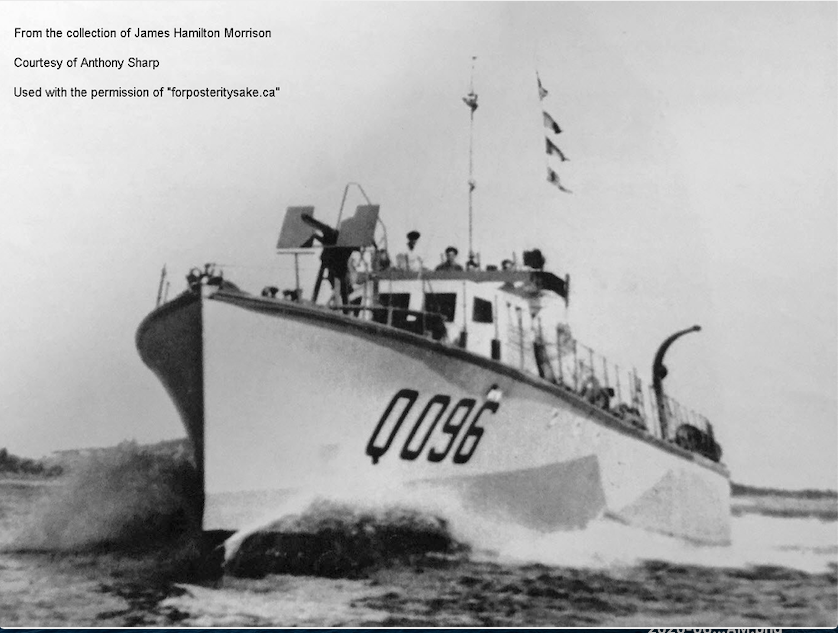
In June of 1945, Q096 began her civilian career when she was sold to Marine Industries Limited of Sorel, Quebec, for the princely sum of $2,000. The following year she changed hands again, when purchased by J.S. Langlois of Savoy Shipping Limited, another Quebec-based company. The transaction price this time was $6,000. In 1947, the vessel was converted into a sightseeing boat at the famous Saint-Laurent Shipyards on the Île d’Orléans and was renamed, Roseline. Her official Transport of Canada registration number was 177959. She was part of the Quebec Waterways Sightseeing Tours Company, used for excursions on the St. Lawrence River in the vicinity of Quebec City.
Roseline was sold once more, in November of 1952, to a pair of Quebec businessmen, Joseph Bouchard and Paul Cauchon, but they didn’t keep the boat for long, selling her once again in June of 1953. The latest buyer was Samuel Sedgwick, a school teacher from Kingston who, a few years earlier, had purchased the 1000 Island Boat Line in Gananoque. To finance the new operation with Roseline, he sold his Gananoque business to another group of owners — Art Bringloe, Grant Lucy, and Walden Beckstead. This newly formed partnership renamed the business as Gananoque Boat Lines.
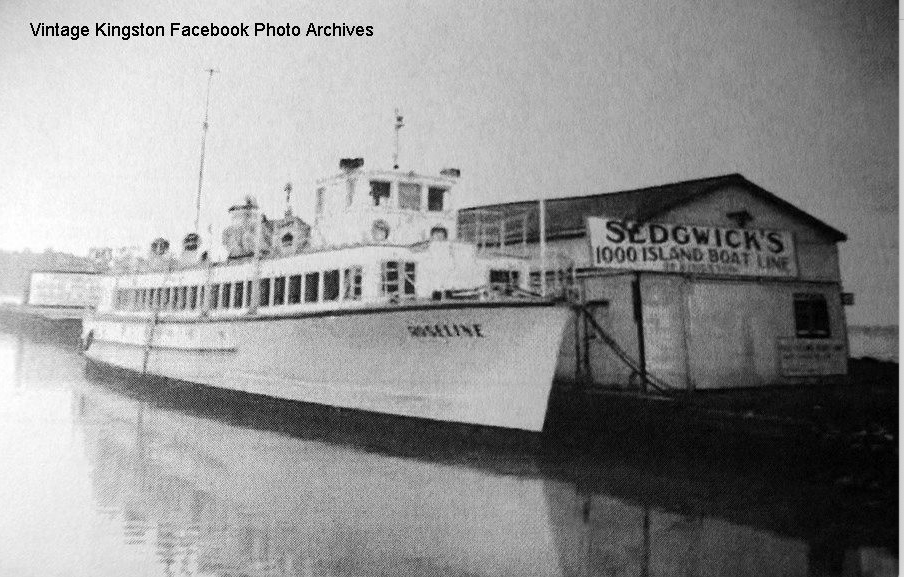
Mr. Sedgwick established a base of operations for Sedgwick’s 1000 Island Boat Line, at the foot of Princess Street on Kingston’s waterfront. The 80-mile, five-hour-long tour was advertised as “the most complete tour of the 1000 Islands.” Setting out from Kingston, the tour’s route headed out across the Forty Acres and crossed into U.S. waters at the foot of Wolfe Island. It proceeded east along the American shoreline to the foot of Wellesley and Zavikon Island, where it entered back into Canadian territory. The excursion then wound its way back west, meandering through the scenic islands, until it reached Gananoque. The return trip to Kingston followed the Bateau Channel, running between the shores of Howe Island and the Canadian mainland. A final pass of Old Fort Henry signaled that the end of the cruise was near. The newly christened Miss Kingston did the tour twice a day—once in the morning and once in the afternoon. As a kid, I recalled that you could almost set your watch by her. The boat did not have radar, but the skippers had developed a method to stay on course and on time when they encountered fog.
It was described by a former captain as follows:
"On a clear day, we recorded compass headings, took stopwatch times, to get from Treasure Island to Quebec Head on Wolfe Island, before entering the main shipping channel on the American side. We had to use the radio-telephone to make a security call, alerting all traffic in the area that we were entering the shipping channel. Half of our tour was in American waters. Usually the fog had cleared by the time we got to the channel so we didn’t have to use the “blind” navigation system too often. Coming back on the Canadian side, there was open area just east of Bishop’s Ferry on Howe Island, where we often ran into line squalls, with high winds and waves for a minute or two. Again, the compass came in handy, along with a steady hand on the wheel."
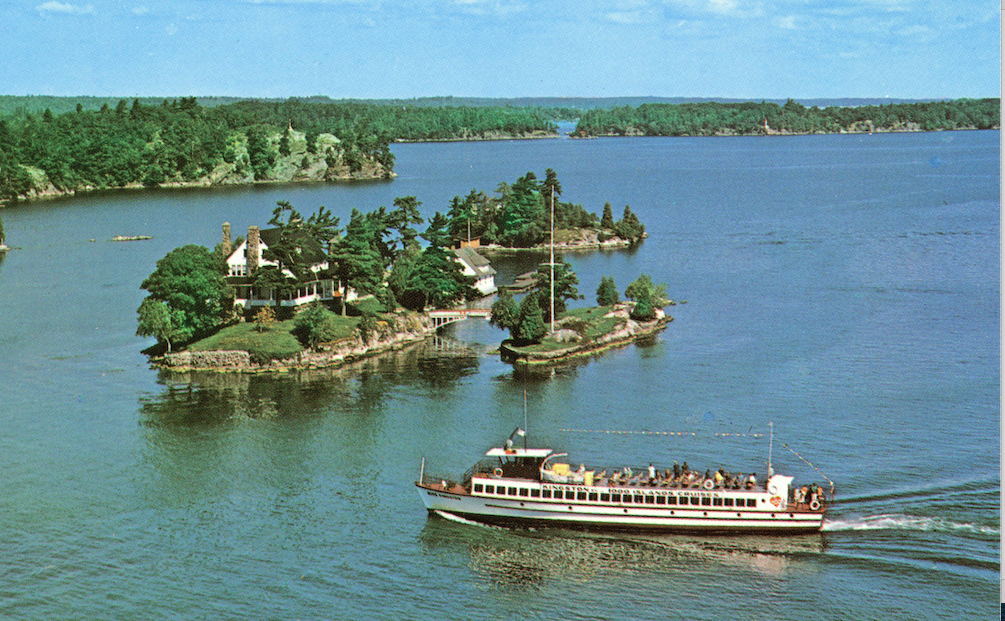
In 1955, Mr. Sedgwick renamed the vessel Miss Kingston, and she also picked up the nickname, “The Honeymoon Cruiser”. The boat was adorned with large red hearts to play up the romantic theme. The advertising brochures at the time also featured the hearts and honeymoon theme.
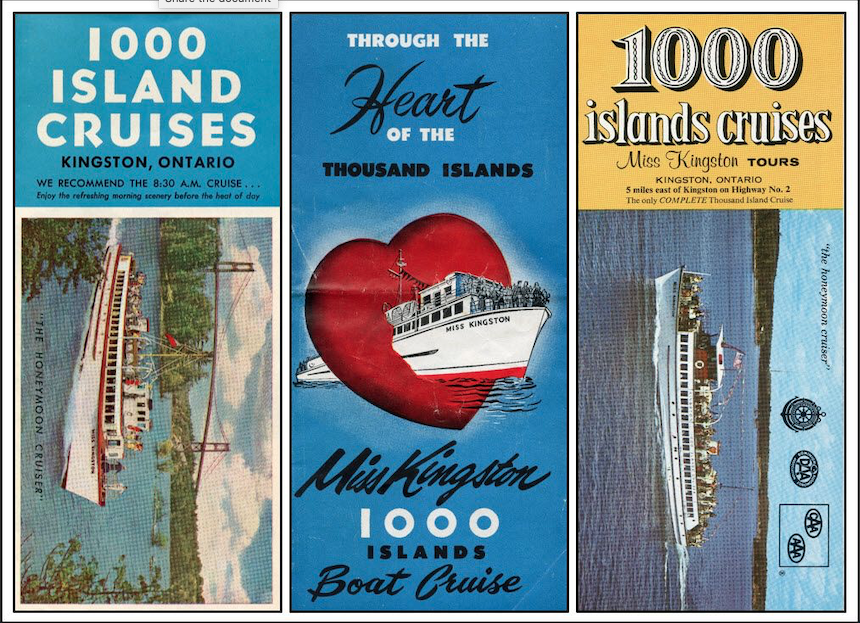
In 1957, Mr. Sedgwick sold Miss Kingston to a pair of businessmen from Port Colborne, Richard Dwor and John Baughman. He continued to offer cruises, on a smaller scale, in his 90-passenger boat, Island Wanderer. The operation that ran the tours out of Kingston under the new ownership was renamed Kingston Excursions Limited and continued to use the pier at the foot of Princess Street. The company had a contract with Canadian National Railway for a “Rail-Boat Excursion” between June 22 and September 7. The day-long excursion began with a train ride from Toronto to Kingston, then the 80-mile cruise through the Thousand Islands, then a train ride back to Toronto.
Two years later, Archie McLean, a Hamilton construction company owner, purchased the corporation from Mr. Dwor and Mr. Baughman. Archie looked after the day-to-day operations of the business in Kingston during the summer seasons and kept his seaplane and pleasure boat at the same dock. A second, smaller boat, Lady Kingston, was added to the fleet in 1960, and she also ran two tours a day. The addition of the second tour boat increased the passenger carry capacity of the fleet to 340; 250 for Miss Kingston and 90 for Lady Kingston.
When construction of the new Holiday Inn began on the waterfront in the mid-1960s, Kingston Excursions Limited, had to find a new place to operate since the wharf at the foot of Princess Street was being taken over by the hotel project. They relocated to the ferry dock at the foot of Barrack Street and ran the two tour boats from that site for several years.
It was also around this time that Lady Kingston underwent a significant rebuild with the addition of a flying bridge and an open deck area at the stern of the boat. She also got a spiffy new blue and yellow paint job. These modifications increased her passenger carrying capacity to one hundred.
I was fortunate to get in touch with a gentleman who had worked on both Miss Kingston and Lady Kingston, and he shared some treasured memories about his days on the boats. Gord Sly worked for Kingston Excursions Limited for about seventeen years. He sold tickets and served as an occasional helmsman/deckhand on Miss Kingston and deckhand on Lady Kingston from 1963 until 1965 at the foot of Princess Street and then later at the foot of Barrack Street and Treasure Island. In 1970, after his first year at Queen's University, he became a captain of the Lady Kingston and worked as her skipper until 1975. In 1976, he received his “Minor Waters” ticket and became a master on Miss Kingston and held that position until 1980.
Captain Sly recalls the modifications to Lady Kingston, and the challenges they presented to the crew members, as follows,
“In 1970, when I returned to be a captain on the Lady, the flying bridge was already there, and the back half of the cabin was an open deck. There was a large transparent (plastic window) canopy that had to be unrolled down the side on the back deck when it rained. Putting that canopy up or down was an interesting challenge while underway. With one hand, we had to hold on to the struts or ribs as we walked along to edge on the outside and maneuvered the canopy into place with the other hand. I don’t recall any of us falling off the boat.”
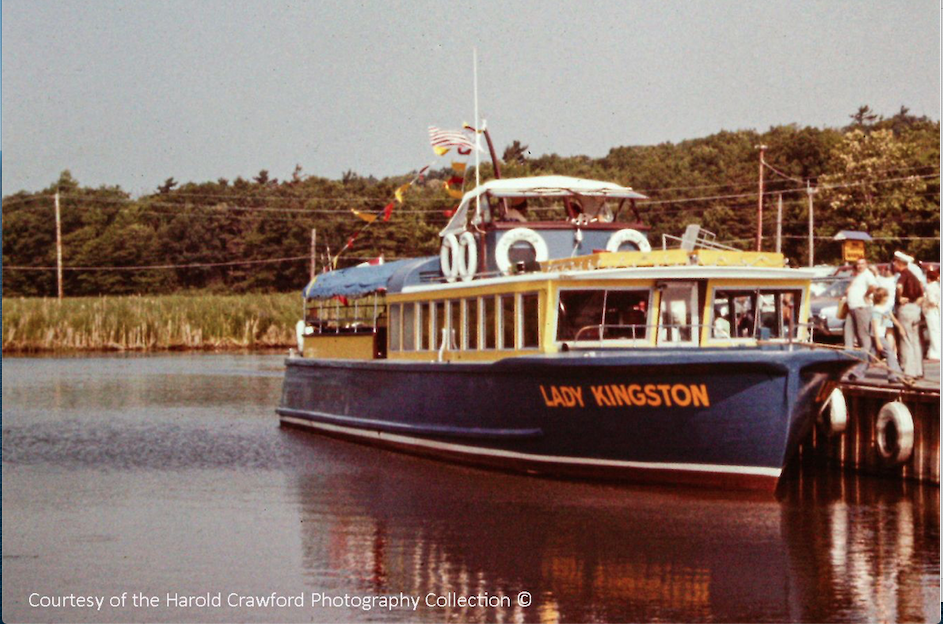
Captain Sly had a fondness for the bigger boat though and explained why, “I liked the Miss Kingston because it was wooden and heavy which reduced drift. The inside of the wheelhouse was so quiet, you could almost hear a pin drop. The rudder response was excellent, making her easy to handle. She sliced cleanly through water and faired well in storms.”
The home base for the boat line was moved, once again, in 1971, to a location five miles east of Kingston, called Treasure Island. The relocation resulted in shortening Miss Kingston's voyage by thirty minutes, but, at four and a half hours, it was still one of the longest Thousand Island tours available. Lady Kingston’s trip, now confined to the Thousand Island Park Islands, was considerably shorter at two and a half hours. A bow-thruster, installed on Miss Kingston after the move to Treasure Island, aided maneuverability since the boat had to be turned around in very limited water space before leaving the docks.
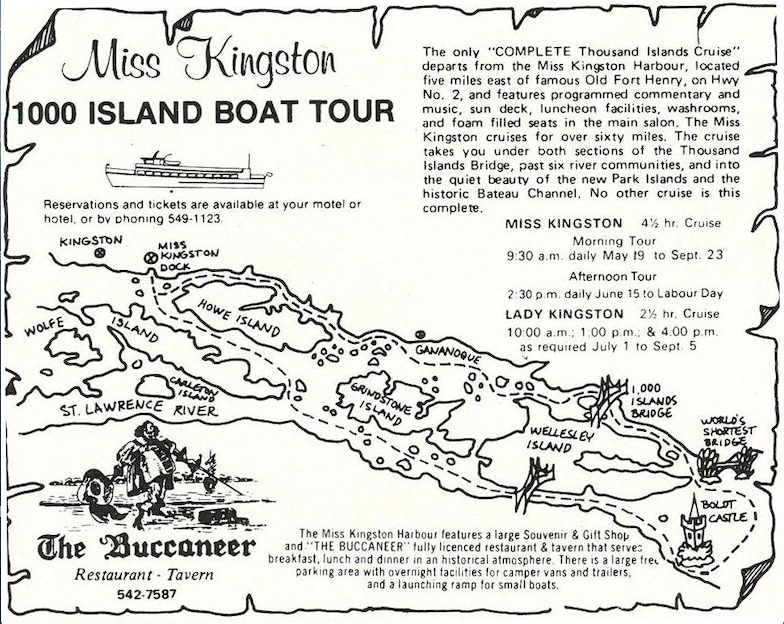
Ownership of the two tour boats changed another time in 1976, when partners Mel Brisbane and Captain Ian Campbell purchased them. Mr. Brisbane owned the property at Eastview, where the boats were operating from at the time, and he was also the proprietor of the Buccaneer Restaurant, which was located at the Treasure Island site. Captain Campbell, with an extensive background in maritime navigation, was one of the skippers of Miss Kingston.
In 1979, the fleet expanded once more with the acquisition of the 102-foot, 400-passenger, triple-deck aluminum Island Queen V from the Thirty Thousand Island Cruise Lines on Georgian Bay, Ontario. She was renamed Miss Kingston II and became the flagship of the boat line. The purchase of the newer and larger vessel made Lady Kingston expendable, and she was sold to a Quebec company. A lot of the crew members recall that the new, metal Miss Kingston II was fairly noisy compared to the old, wooden Miss because the engine vibrations transmitted through the boat.
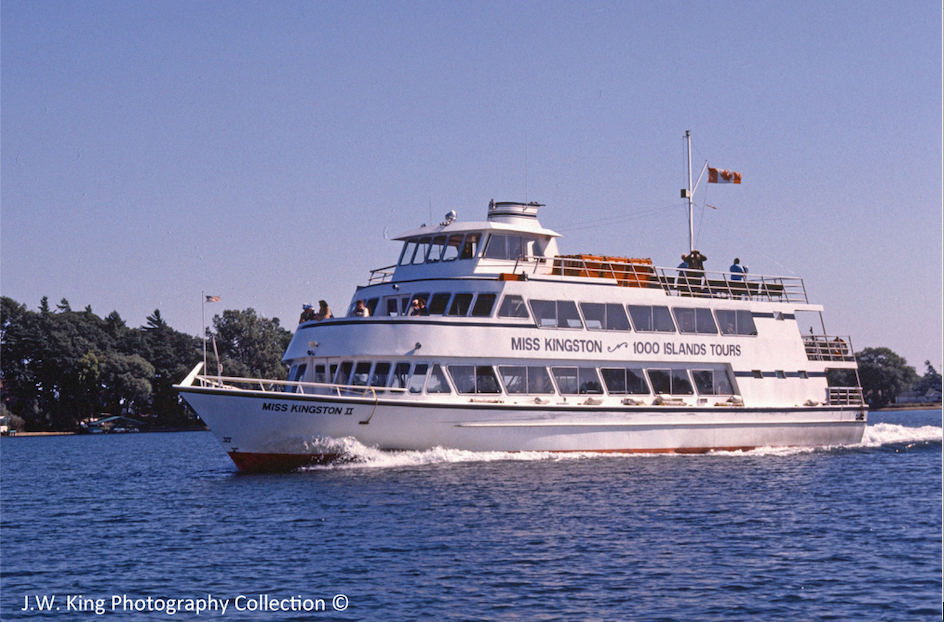
Mr. Brisbane and Captain Campbell operated the business until 1985 when the Eastview property was sold to make way for the new Treasure Island Marina development. At that point, the two vessels were also liquidated. Miss Kingston II changed hands several times over the following years, renamed each time. Since the time that she was Miss Kingston II, the boat has carried the names M.V. Montreal, Dalhousie Princess, and, most recently, Empress of Ottawa. She continues to operate regularly in Ottawa. The original Miss Kingston was sold to a new owner in Quebec and renamed Saint-Louis IV. She was sold once more, renamed La Santa Maria IV, and, as word has it, relocated to the Caribbean for charter work. The vessel was suspended from the Transport Canada Registry in 2004, and I have not been able to trace her Caribbean history or ascertain her current status despite hours of internet searching.
The boats themselves were mere objects, of course, and it was the people who operated and worked on them that brought them to life. Over the years, there were many different captains at the helm of Miss Kingston, Lady Kingston, and Miss Kingston II; they all brought unique resumes and personalities to the position. Captain Brian Johnson, a regular contributor to Thousand Islands Life, and who once served as a mate on Miss Kingston, recalls a couple of the old captains. Captain Sebastian "Joe" Sisty was from Iroquois, Ontario, and was captain of MS Wolfe Islander from 1948 to 1952. He then joined Miss Kingston as her captain and worked until Captain Ross Carnegie arrived in 1956. Captain Carnegie operated the ferry Champion from Gananoque, Ontario, to Clayton, New York, until the newly built Thousand Islands Bridge was opened in 1938. He then went on to be captain of the SS Wolfe Islander, an old paddle wheeler, from 1941 to 1944. He captained the newer MS Wolfe Islander from 1953 to 1955. In 1956, he became captain of Miss Kingston and held that position until he retired in 1970. Ross was a member of the Carnegie family who operated the Rockport, Ontario, ferries to Alexandria Bay, New York, prior to the Thousand Islands Bridge construction.
Terry Froats of Kingston also has fond memories of some of the captains he worked under. He wrote, “In 1973, I was a deckhand and a wheelsman on the Miss Kingston and worked under Captain Ross Carnegie, Captain Ben Bowen, and Captain Brooks. All great guys, but I have to say Captain Bowen was one of the coolest guys I have ever met. Super nice and what a storyteller.”
I had the pleasure of conversing personally with Lew Babcock, another gentleman who worked aboard Miss Kingston back in the 1970s, and I asked him about his duties as the wheelsman on the boat. He recalled, with a chuckle, one of the tasks that he had to carry out and the inherent risks associated with it. “When we got near Kingston,” Lew explained, “I had to climb to the roof of the wheelhouse and remove the American flag. Sometimes that portion of the trip was the scariest because we had to do it no matter the weather or wind speed. There was an occupied island that we passed during the flag takedown, and on a few occasions, the occupant(s) got a great thrill seeing our reaction after they fired off a small brass cannon just when we were on the roof. The first time I almost fell off the wheelhouse roof, but I knew better for the other afternoon trips. I did forget the second season I worked the ship, and again, I almost fell off the roof.”
Lew also recalled another Miss Kingston incident that nearly had a tragic outcome. “On an afternoon cruise coming back up the Canadian side, there were four people, two men and two women, standing on the end of a dock about one hundred feet from the ship, all naked. The ship had a full load, and once word got around, everybody went to the starboard side for the view. The ship listed so badly that the captain had to get on the PA system and direct the passengers to return to their seats or risk tipping the ship over.”
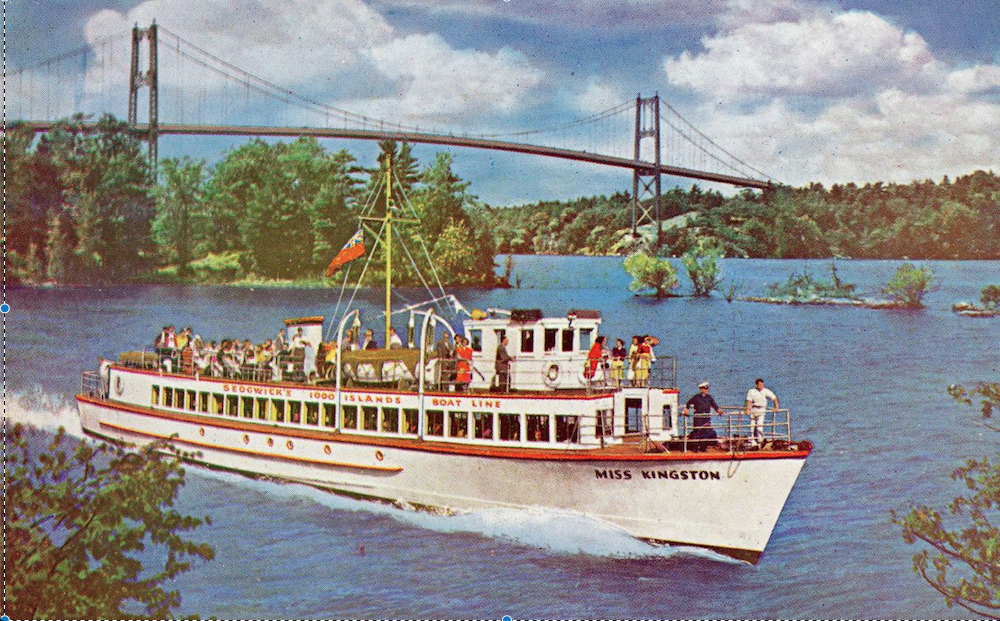
Another recollection of Lew’s that will hold special memories for Kingstonians was about what the boat’s crew wore while on duty. “We had khaki uniforms, both shirt & pants. There was a sailor type peaked hat in khaki as well. We had to purchase them ourselves, and they were only available at the S&R store.”
In addition to the operating crew, Miss Kingston also carried staff for the canteen and souvenir stand. Donna Gabourie was employed in that area for five years back in the 1960s and worked one shift a day, seven days a week for ten weeks each summer. If you wanted a day off, you would work a double shift for someone, and then they would cover the shift you wanted off. She recalls the canteen area as, “one long counter – one end souvenirs – other sold hamburgers, hot dogs, grilled cheese, no French Fries, potato chips, etc., pop, coffee.” Donna also remembers that the canteen got really busy on the morning cruise as soon as the boat passed under the American span of the Thousand Islands Bridge. Lew Babcock had great memories of the food onboard too. As he recalls, “There also was a crew of girls who worked the canteen on the ship. We were responsible for our own meals if we wanted one during our break. They put out the best toasted western that I've ever had.”
From her keel laying in 1942, until stricken from the Canadian Vessel Registry in 2004, this old boat had a colourful life and touched the lives of many people. Miss Kingston has rightfully earned her place in the history books!
Acknowledgments
I would like to thank the following individuals who either provided information for this story, shared personal experiences related to the Miss Kingston, or allowed me to use their wonderful photographs:
Mr. Lew Babcock
Mr. Pat Crawford
Mr. Jeff Dwor
Mr. Terry Froats
Ms. Donna Gabourie
Capt. Brian Johnson
Capt. Gord Sly
Mr. Garry Weir
I am particularly grateful for the assistance provided by Judy Keeler who proof-read the article, suggested editorial revisions to improve the story and brought me into compliance with the Grammar Police.
By Tom R. King
Tom King and his wife Marion have lived in Milton, Ontario for the past 35 years, where they both worked and raised their family of three children; Kris, Mike and Becca. Tom has captured the history of the tour boat industry as well as giving us the best spider story in the past 15 years!
Read more articles by Tom King here in our new format for TI Life, and more articles on our old site.
Posted in: Volume 15, Issue 7, July 2020, History, People, Poetry, Sports
Please click here if you are unable to post your comment.
